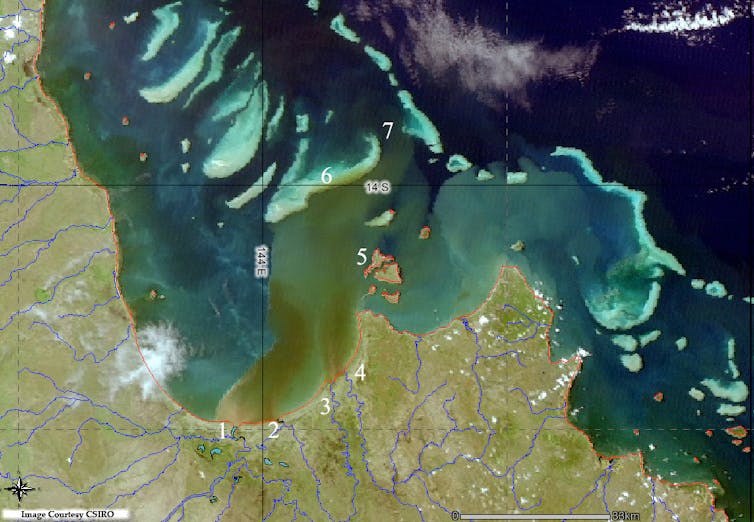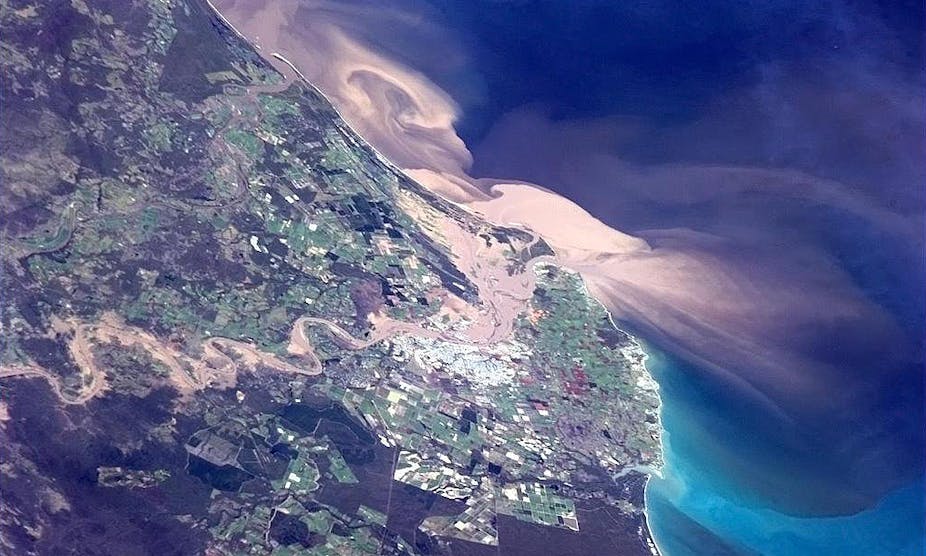This article is part of a series examining in depth the various threats to the Great Barrier Reef.
Over the past 170 years, the dozens of river catchments that empty into the waters around the Great Barrier Reef (GBR) have seen huge amounts of agricultural and urban development. As a result, these rivers now wash significant amounts of sediments, nitrogen, phosphorus and pesticides onto the reef.
While difficult to estimate precisely, loads of fine sediment and nutrients have all increased by several times, while the waters are also polluted with synthetic organic pesticides that were not there before about 70 years ago.
The effects of these pollutants include:
Waters less than 25 m deep have become cloudier, reducing the sunlight available for the growth of corals, seagrass and marine algae.
Outbreaks of crown of thorns starfish have become more frequent as a result of the extra nutrients in the water, increasing the rate of coral deaths.
Some reefs have shifted from being coral-dominated to being dominated instead by algae and other organisms, again driven by increased nutrient loads.
Coral diseases have increased as water quality has declined.
These effects, together with those of climate change, have contributed to the severe decline in the overall health of the GBR.

What is being done about it?
By 2003, the scientific evidence was sufficiently strong, and the political climate sufficiently favourable, for an official plan to be drawn up to improve water quality on the reef. The result was the Reef Water Quality Protection Plan 2003, a joint effort between the Commonwealth and Queensland governments.
The plan’s main focus was to improve farming practices in the water catchments that feed onto the GBR, through changes to fertiliser use, pesticide application and beef grazing management. But the plan was not substantially funded until 2008, when the Commonwealth government (with state support) finally provided A$200 million over five years, with farmers who successfully apply for grants having to match the funding themselves.
From 2008 to 2013, this investment delivered modest successes in reducing the burden of sediment, nutrients and pesticides on the reef. Reported improvements, after discounting time lags in the system, include on average 11% reductions in human-contributed fine sediments, 10% reductions in nitrogen, no reported reduction in phosphorus, and 28% reductions in targeted pesticides.
However these reductions fell well short of the actual targets set to be achieved by 2013: a 20% reduction in fine sediment, a 50% reduction in both nitrogen and phosphorus, and a 50% reduction in pesticide loads. What’s more, the updated version of the water quality plan, released in 2013, sets new targets for 2018 but these, surprisingly, are only equal to or less than the targets originally set for 2013.
Plans still not sufficient
The basic problem is that these official water quality targets have never been strong enough to properly protect the species and ecosystems of the GBR. This is despite the fact that both the 2009 and 2013 editions of the water quality plan had an explicitly ecological goal:
To ensure that by 2020 the quality of water entering the reef from broad scale land use has no detrimental effect on the reef’s health and resilience.
The current water quality targets are not set to achieve this overall goal. What we need instead are what I refer to as “ecologically relevant targets” (ERTs).
ERTs have already been developed to safeguard water quality in some regions of the GBR such as the rivers of the Wet Tropics and the Burnett Mary region, and are also currently being prepared for the Burdekin and Fitzroy river regions.
Yet the message is still not getting through as far as the GBR is concerned. The Commonwealth and Queensland governments’ Reef 2050 Long-Term Sustainability Plan, released earlier this year, is supposed to provide a comprehensive blueprint for protecting the reef. But its first draft featured little input from leading scientists and listed only the flawed 2013 water quality targets, with no estimate of the funding required to meet even these inadequate measures.
With the advent of the new Queensland government earlier this year, the Reef 2050 Plan was revised, and its water quality section now includes a preliminary attempt to include ecologically relevant targets. But the final plan still contains no estimate of the cost, despite the availability of a current estimate that puts the figure at A$785 million by 2020.
These details could easily have been included, given that the Reef 2050 Plan was two whole years in the making, although it is worth noting that the recent Federal Budget did include a pledge of A$100 million towards preserving the reef.
Decision in the balance
With the United Nations set to decide on whether to add the reef to its list of World Heritage in Danger, Australia is presenting a rather flawed plan in terms of water quality (as well as on climate change and port development, as seen elsewhere in this series). This is particularly regrettable, given the millions of dollars spent by the scientific community on research and monitoring, the results of which were readily available to those drafting the plan.
Management of terrestrial pollutant runoff is critical for the long-term condition of the GBR as this is one sector where progress (albeit modest) is actually being made. With more investment in collaboration with the farming sector, we can further reduce sediments, nutrients and pesticides flowing onto the reef.
That would help to make the reef more resilient, to some extent at least, against the growing impacts of climate change. We already know that many climate change impacts, such as coral bleaching and disease, are worsened by poor water quality.
Meanwhile, as we get to grips with “conventional” pollutants on the GBR, we are now also facing a multitude of new ones, including microplastics, drugs, coal dust, and other synthetic chemicals, the effects of which are far from clear.
Without a better long-term plan, featuring strong, credible targets and enough money to deliver on them, it is inevitable that water pollution will continue to take a toll on the Great Barrier Reef. This treasured ecosystem will continue to suffer, and the increasing effects of climate change will only hasten its decline.

